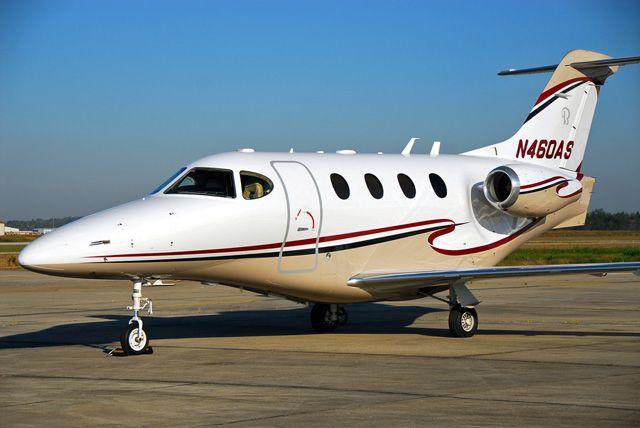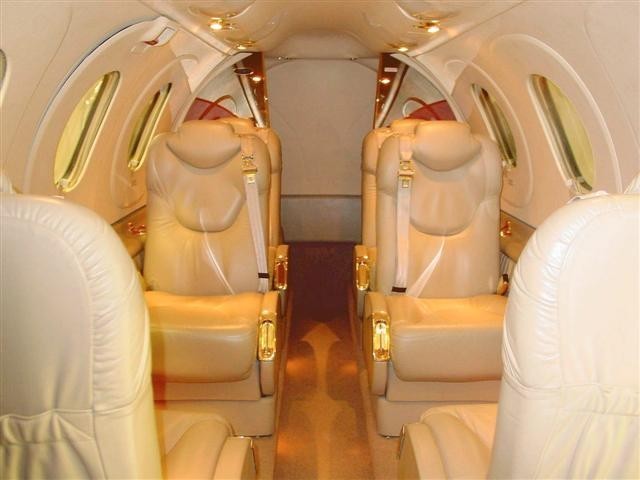


Aircraft Description
To begin with, the Premier I’s cabin is one of the biggest for a private jet of its size, seating six or seven passengers in a 315 cubic-foot cabin. The cabin is very well-insulated due to the carbon fiber/epoxy honeycomb composite fuselage. Fold-out tables on both sides of the aircraft, and fully adjustable, extra-wide seats make for a comfortable flight. Additional options include an array of cabin entertainment systems and interior trim/finish upgrades. There is 77 cubic feet of baggage space available in internal and external baggage compartments, and the external baggage compartments can be heated, if desired.
The Premier I can take off in 3,792 feet and climb to 37,000 feet in seventeen minutes when loaded to its maximum takeoff capacity of 12,500 pounds. Its cruise speeds can reach 451 ktas (.785 Mach). Its maximum range is 1,726 miles (1,500 nautical miles).
The swept wings on the Premier I are an original design from Raytheon. The unique design minimizes drag, and increases cruise speed and high altitude capabilities. Although the wing was enlarged to add an additional 250 pounds of fuel than was originally planned, the Premier I still manages a short enough takeoff distance to be able to utilize small airports.
The Premier I is powered by two Williams/Rolls-Royce FJ44-2A engines, which provide 2,300 pounds of thrust on take off, apiece. They are controlled by an electronic control unit that is linked to a hydromechanical fuel control system mounted on the engine. Manual control, although not usually utilized, can be used in emergencies.
The computer-controlled manufacture line (known as the “Viper process”) used in the production of the Premier I is a big reason for its low acquisition cost. Computer aided three-dimensional interactive analysis (CATIA) simulations analyzed structural models and system design of the jet to optimize its performance and reliability, and cut down production time and costs.
The fuselage of the Premier I is made of a high-strength carbon fiber/epoxy honeycomb composite. It is lightweight, simple to manufacture, and almost never needs repairs. The thinness of the fuselage is the reason for the cabin’s spaciousness.
Cabin pressurization is automatically regulated by a digital system that uses engine bleed air. The two-zone cabin environmental system also uses bleed air for heating. Cabin pressure can be automatically or manually controlled and is rated to a maximum of 8.4 psi.
| General | Premier I, RA-390 | |||
|---|---|---|---|---|
| Category | Jet < 20,000 lbs. | |||
| Years Aircraft Manufactured | 2001 – 2006 | |||
| Serial Number Range | RB-0001-RB-0160 (up) | |||
| Retail High Price | $4,200,000.00 / 3,295,740.00€ | |||
| Retail Low Price | $3,700,000.00 / 2,903,390.00€ | |||
| Characteristics | Premier I, RA-390 | |||
| Seating | 1+6/7 | |||
| Wing Loading | 55.6 | |||
| Power Loading | 2.7 | |||
| Noise(EPNdB): Takeoff/Sideline/Approach | 78.3/87.9/92.0 | |||
| External Dimensions (ft) | Premier I, RA-390 | |||
| External Length | 46.0 | |||
| External Height | 15.3 | |||
| External Span | 44.5 | |||
| Internal Dimensions (ft) | Premier I, RA-390 | |||
| Internal Length (Overall/Net Height) | 13.5/11.2 | |||
| Internal Height | 5.4 | |||
| Internal Width (Max/Floor) | 5.5/3.7 | |||
| Baggage | Premier I, RA-390 | |||
| External: Cu.Ft./Lb. | 23/210 | |||
| External: Cu.Ft./Lb. | 54/550 | |||
| Power | Premier I, RA-390 | |||
| Engines | 2 Wms/RR FJ44-2A | |||
| Output (lbs ea.)/Flat Rating | 2,300/ISA+13 | |||
| Inspection Interval | 3,500t | |||
| Data based on latest manufactured year | ||||



